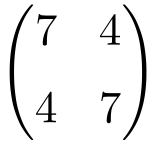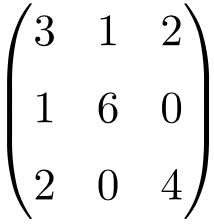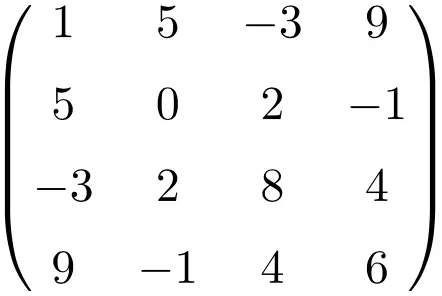On this post you will find the explanation of what symmetric matrices are. In addition, we show you how to quickly identify when a matrix is symmetric, as well as several examples. You will also find all the properties of symmetric matrices. And finally, we explain a special peculiarity that any square matrix has: it can be decomposed into the sum of a symmetric matrix plus an antisymmetric matrix.
Table of Contents
What is a symmetric matrix?
The definition of symmetric matrix is as follows:
A symmetric matrix is a square matrix whose transpose is equal to the matrix itself.
Where is the transpose of matrix
.
See: what is the transpose of a matrix?
Once we know the concept of symmetric matrix, let’s see how any symmetric matrix can be easily identified:
How do you know if a matrix is symmetric?
A matrix is symmetric when the element in row i and column j is identical to the element in row j and column i, and the values of the main diagonal of the matrix can be any.
Thus, the main diagonal of a symmetric matrix is always an axis of symmetry, in other words, it is like a mirror between the numbers above the diagonal and those below. That is why this type of matrix is called symmetric.
Examples of symmetric matrices
Several examples of symmetric matrices are shown below to fully understand their meaning:
Example of a 2×2 symmetric matrix

Example of a 3×3 symmetric matrix

Example of a 4×4 symmetric matrix

When transposing these three matrices it is proven that they are symmetric, because the transpose of each matrix is equivalent to its respective original matrix.
Properties of symmetric matrices
The characteristics of symmetric matrices are as follows:
- The addition (or subtraction) of two symmetric matrices results in another symmetric matrix. Since transposing two added (or subtracted) matrices is equivalent to transposing each matrix separately:
- Any symmetric matrix multiplied by a scalar equals also to another symmetric matrix.
- The product of two symmetric matrices is not always equal to another symmetric matrix, only if the two matrices can be commuted. This condition can be demonstrated with the multiplication property of the transpose of a matrix:
See: how to multiply two matrices.
- The power of a symmetric matrix gives another symmetric matrix, as long as the exponent is an integer.
- Obviously, the Identity matrix and the Null matrix are examples of symmetric matrices.
- A matrix that is congruent with a symmetric matrix must also be symmetric.
- If a symmetric matrix is invertible, then its inverse matrix is also symmetric.
- The same happens with the adjoint of a symmetric matrix: the adjoint matrix of a symmetric matrix results in another symmetric matrix.
- A symmetric matrix with real values is also a normal matrix.
- Since symmetric matrices are a special case of Hermitian matrices, all the eigenvalues of a symmetric matrix are real numbers.
- The spectral theorem tells us that all matrices whose elements are real are diagonalizable matrices and, furthermore, the diagonalization is done by means of an orthogonal matrix. Therefore, all real symmetric matrices are diagonalizable by orthogonal matrices.
- On the other hand, symmetric matrices with complex numbers can be diagonalized with a Unitary matrix.
- The Hessian matrix is always symmetric.
Decomposition of a square matrix into a symmetric and an antisymmetric matrix
A property that all square matrices have is that they can be decomposed into the sum of a symmetric matrix plus an antisymmetric matrix.
The formula that allows us to do it is the following:
Where C is the square matrix that we want to decompose, CT its transpose, and finally S and A are the symmetric and antisymmetric matrices respectively into which matrix C is decomposed.
Below you have a solved exercise to see how it is done. We are going to decompose the following matrix:
We calculate the symmetric and antisymmetric matrix with the formulas:
And we can check that the equation is satisfied by adding both matrices:
✅